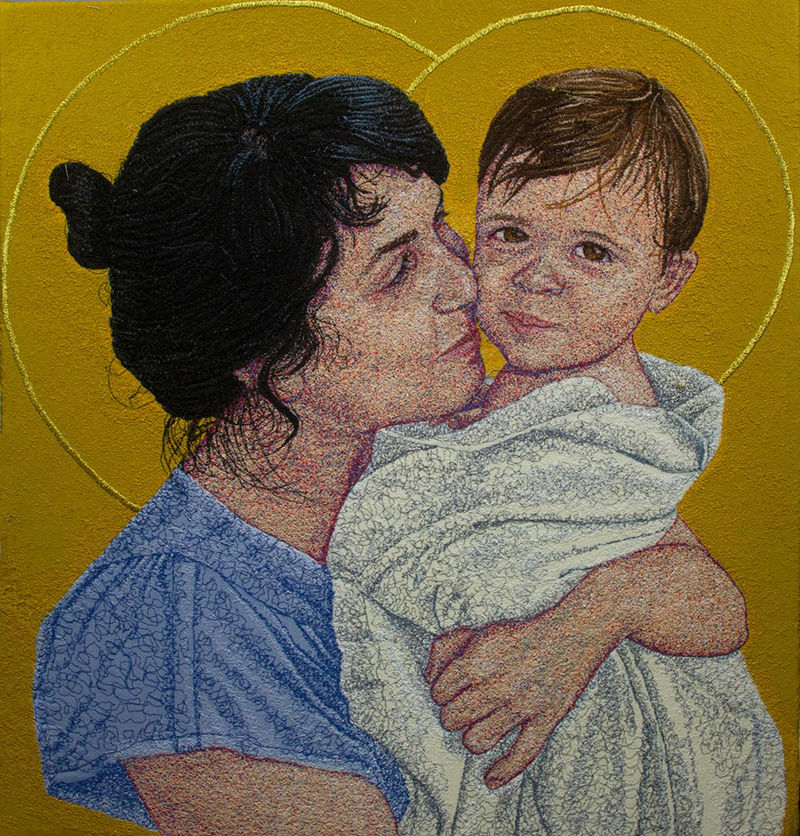Father Frank Sabatté is a Paulist priest and a random-stitch portrait embroiderer who heads up an arts collective in NYC called “Openings.”
In fostering the nexus between spirituality and creativity, “Openings” believes that the connections between creativity and transcendence foster critical conversations that have the potential to unite individuals across cultural divides.”
What could be more “catholic” than fostering conversation around and about creativity?
Father Sabatté grew up in San Jose and studied art at the College of Fine Arts, UCLA. That was when he got to know the Paulist Fathers at the Newman Center.
What struck me about them was how human they were. They were real, and they were amazing preachers. One priest in particular, Father Ken McGuire, became my spiritual director and eventually, a dear friend. He had an amazingly brilliant mind. We formed a community, a bunch of us. I’m 64. So I went through the old Church.
He joined the Paulist Fathers, was ordained in 1980, and spent 26 years at various assignments: Connecticut, Berkeley, UC San Diego, Tucson.
That was when the Paulist Fathers said, “Why don’t you go to our mother house in New York and try to get something together with artists?”
“I didn’t like the idea of living in New York at all! I’m a Californian. But in 2006 I went,” recalled Father Sabatté.
He started by meeting with a young parishioner, a convert who wanted to start something for artists. They “kind of brainstormed.” He also started to visit artists, particularly young-adult open studios at the major NYC schools. He’d simply go out, chat, meet people. As a devout introvert, that was a challenge.
“I deliberately did not wear a collar because I believe that what a priest wears is not for him but for the people he serves. Father Isaac Hecker, our founder, said a Paulist should dress like a gentleman of the time.
“My intention at the beginning was basically, ‘I’ve got to get this program going.’ Then, I had this experience with a young artist. We were talking, and in the back of my mind I was thinking, ‘Maybe I could get her to join my group.’ And after I left, it hit me like a thunderbolt.
“I thought, ‘She knew that I had an agenda. She knew that my program was what mattered.’ So I dropped it. From then on the program didn’t matter. What mattered was the person standing in front of me.
“Now I say, ‘Tell me about your work.’ I don’t ask, ‘What does it mean?’ I say, ‘What’s pulling you? What’s sparking inside of you? What’s nudging you?’ And then we get to talking. And then I introduce myself. I say, ‘My name is Frank. I’m an artist and a Catholic priest.’ And then the conversation can continue.”
Eventually he and four or five other people formed a team and started a discussion group at St. Paul the Apostle, the third largest church in Manhattan. That first group went up and down and then died.
Father Sabatté had expected as much. But they’d already built up a network. And in spite of the fact that most of the young adults he’d met were very nervous about the institutional Church, they’d already had three very successful exhibits.
“St. Paul the Apostle is like a cathedral. It’s huge. We put the art in the side chapels. The first event, in 2006, was with eight artists. At the second reception the following year we had 16 artists.
“In 2011, we had 24 artists and 800 at the reception. Young artists, hipster types, parishioners, Catholics, ex-Catholics, Hindus, Buddhists. And we all hung out. Food, wine.
“The root of the word ‘conversation’ is conversion, which is different from proselytizing. In a conversation, the Spirit will change both of us.”
About 10 years ago Father Sabatté was going through some major life changes. On sabbatical in L.A., he went with a friend to the Cathedral of Our Lady of the Angels. Inside he saw the tapestries of the saints by John Nava.
“I was stunned. I said, ‘I’ve got to do something like this.’ I did some research, and discovered a form of Chinese embroidery, developed in the ‘20’s, called random-stitch embroidery. The layered stitches, all painstakingly done by hand, are often used for portraiture.”
Later he discovered free motion embroidery, thought to combine the two methods, and acquired a machine with an adjustable stitch. He begins by tracing the design from a photograph, then drawing it freehand on canvas.
“I did some faces, the old priests I lived with. But I didn’t want to just do ‘religious’ art. ‘Cambodia, 1975,’ is a young girl based on a photograph taken by the Khmer Rouge. They used to photograph their victims before they tortured and killed them. This maybe 13-year-old girl seems to look right through you.
“The Magdalene” depicts an exhausted, strong, sensitive young woman you might spot riding home on a city bus. He’s done Bathsheba, an interracial couple named Joey and Lisa, and “Sweat Shop Girl.”
He’s done Father Isaac Hecker and his own wry, bow-tied father.
Every artist lives in the constant tension between solitude and community. “Openings” begins to bridge the gap.
For more, visit sabatteart.com.
Heather King is a blogger, speaker and author of several books.

